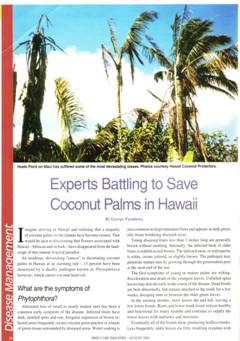Experts Battling to Save Coconut Palms in Hawaii
By George Furukawa, August 2003, Tree Care Industry
 Imagine arriving in Hawaii and realizing that a majority of coconut palms on the islands have become extinct. That would be akin to discovering that flowers associated with Hawaii – hibiscus and orchids – have disappeared from the landscape of this remote tropical paradise.
Imagine arriving in Hawaii and realizing that a majority of coconut palms on the islands have become extinct. That would be akin to discovering that flowers associated with Hawaii – hibiscus and orchids – have disappeared from the landscape of this remote tropical paradise.
An insidious, devastating “cancer” is decimating coconut palms in Hawaii at an alarming rate – 15 percent have been destroyed by a deadly pathogen known as Phytophthora katsurae, which causes coconut heart rot.
What are the symptoms of Phytophthora
Abnormal loss of small to nearly mature nuts has been a common early symptom of the disease. Infected fruits have dark, mottled spots and rots. Irregular expansion of brown infected areas frequently creates circular green patches or islands of green tissue surrounded by diseased areas. Water soaking is also common on large immature fruits and appears as dark green, oily tissue bordering diseased areas.
Young diseased fruits less than 3 inches long are generally brown without mottling. Internally, the infected husk of older fruits is reddish to red-brown. The infected meat, or endosperm, is white, cream colored, or slightly brown. The pathogen may penetrate mature nuts by growing through the germination pore at the stem end of the nut.
The first symptoms of young or mature palms are wilting, discoloration and death of the youngest leaves. Unfurled spear leaves may also die early in the course of the disease. Dead fronds are bent abnormally, but remain attached to the trunk for a few weeks, drooping onto or between the older green leaves.
